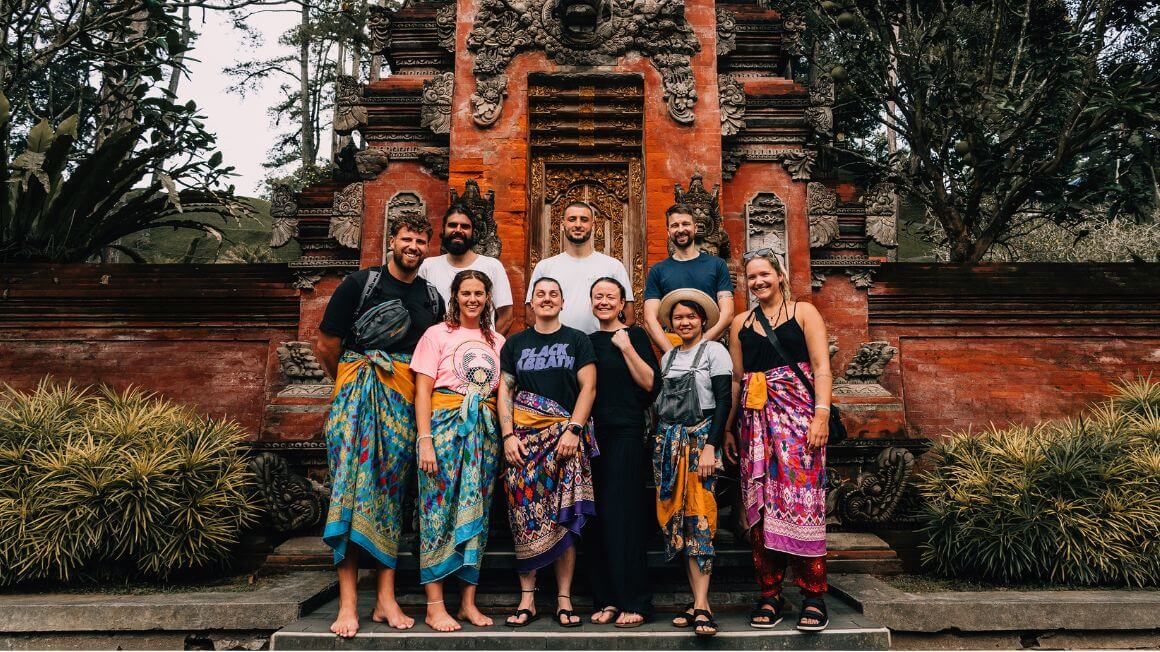The Broke Backpacker is supported by you. Clicking through our links may earn us a small affiliate commission, and that's what allows us to keep producing free content 🙂 Learn more.
Let’s get one thing straight: Turkey isn’t just kebabs and carpets. Sure, those are there, and they’re bloody good, but Turkey threw me off—in the best way. With an unusual blend of ancient ruins, turquoise coastlines, and out-of-this-world landscapes, a trip to Turkey will be one you won’t forget any time soon.
I’ve drunk tea with Grand Bazaar shopkeepers, floated over Cappadocia at sunrise, and eaten olives picked straight from the tree like some Mediterranean local. Turkey isn’t just another stop on the way somewhere else. It IS the destination.
Between getting lost in spice markets (seriously, it’s a rite of passage), surviving the chaos of Turkish bus journeys, and going toe-to-toe with shopkeepers over prices, I’ve picked up more than souvenirs—I learned how to haggle like I was born and raised in a bazaar.
I’ve pulled together Turkey travel tips that’ll actually help—budgeting without killing your backpacker budget, finding the best bits whether that be beaches or you daily dose of ruins, and properly soaking up the madness that makes Turkey unforgettable. Let’s dive in.
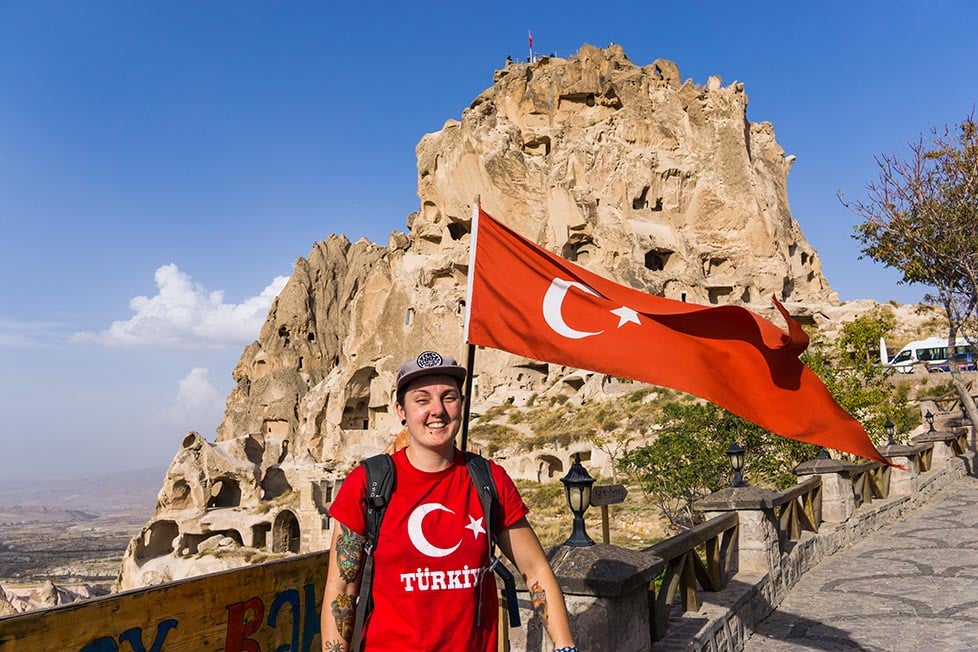
Image: Nic Hilditch-Short
The Broke Backpacker is supported by you. Clicking through our links may earn us a small affiliate commission, and that's what allows us to keep producing free content 🙂 Learn more.

Do You Want to Travel FOREVER??
Pop your email in below to get a FREE copy of ‘How to Travel the World on $10 a Day!’.
- 1. Choose the Right Time to Visit
- 2. Dress Modestly in Religious Sites
- 3. Pack Appropriately for Diverse Climates
- 4. Save Time with Cheap Domestic Flights
- 5. Shop at the Grand Bazaar
- 6. Savour Turkish Cuisine
- 7. Dine at Local Eateries
- 8. Sip Turkish Tea
- 9. Treat Yo’self to a Traditional Hammam
- 10. Respect the Power of the Evil Eye
- 11. Discover Hidden Ancient Ruins
- 12. See the Sunrise at Mount Nemrut
- 13. Sip Turkish Coffee
- 14. Hike to Sumela Monastery
- 15. Cappadocia Isn’t Just for Hot Air Balloons
- 16. Road Trip Along the Turquoise Coast
- 17. Learn 5 Key Turkish Phrases
- 18. ALWAYS Travel With Insurance
- Final Thoughts on Turkey Travel Tips
- Buy Us a Coffee!
1. Choose the Right Time to Visit
Let me tell you—after freezing my toes off in Cappadocia’s winter and nearly melting into a puddle during an Istanbul August heatwave—I’ve cracked the code. Skip the extremes. The best times to visit Turkey are spring (April–June) and fall (September–October). Think pleasant 20-25°C days, Ephesus without the selfie-stick armies, and flights and hotels that won’t drain your wallet.
Want to lounge on Antalya’s beaches without playing towel Tetris? Or wander Cappadocia’s valleys without elbowing through crowds? This is your golden window. Trust me, shoulder seasons are Turkey’s best-kept secret, no matter where you decide to stay in Turkey.
If you’re not into sardine-packed beaches and heat that could fry an egg (we’re talking 35°C meltdowns), steer clear of July and August. And yeah, some coastal spots ghost town out by winter (November–March), but hear me out: Winter’s got magic. Picture skiing in Uludag, Cappadocia’s fairy chimneys dusted with snow like a storybook scene, and Istanbul’s cosy cafes without the tourist stampede.
Oh, and here’s a secret: Snag domestic flights (like Istanbul to Cappadocia) for as low as $30 in off-peak months. Who said you can’t travel in winter? Between you and me, this is a travel hack for all broke backpackers in Turkey.
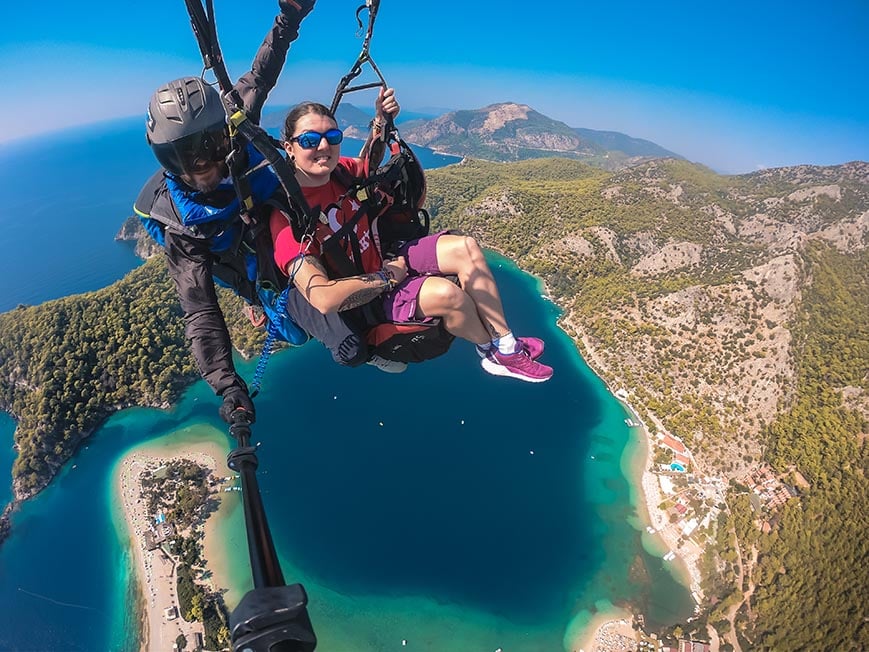
Image: Nic Hilditch-Short
Psst, I’ve got news… we’ve launched an online community and you’re invited <3
“Broke but Backpacking” is a WhatsApp community full of passionate travellers who love to exchange tips, stories and inspiration. Connect with like-minded backpackers and be the first to hear about exclusive deals and giveaways designed just for the community.
Join the Crew2. Dress Modestly in Religious Sites
Show up in shorts and a tank top on a Blue Mosque or Hagia Sophia tour, and you’ll be turned away at the door. These sites have strict dress codes—shoulders, arms, and knees must be covered. Flowy pants, maxi skirts, and long sleeves do the job without sacrificing comfort.
Don’t stress too much about showing up unprepared, as most mosques have loaners. I once rocked a floral number at Suleymaniye Mosque that looked straight out of my grandma’s couch… awkward, but hey, free souvenir vibes.
My insider tips:
- Socks are your friend. You’ll ditch shoes inside, and nobody wants to wince their way across icy marble floors.
- Skip the see-through stuff or bodycon fits. Modesty isn’t a suggestion here—it’s the rulebook.
Outside Istanbul’s tourist zones, dial it up. In rural spots like eastern Anatolia or villages near Konya, even cafes and markets side-eye bare shoulders. Turkey’s secular, sure, but blending in earns respect. I swapped my crop tops for breezy linen shirts and maxi skirts—turns out, looking like a Turkish Living cover model also beats sweating through a heatwave.
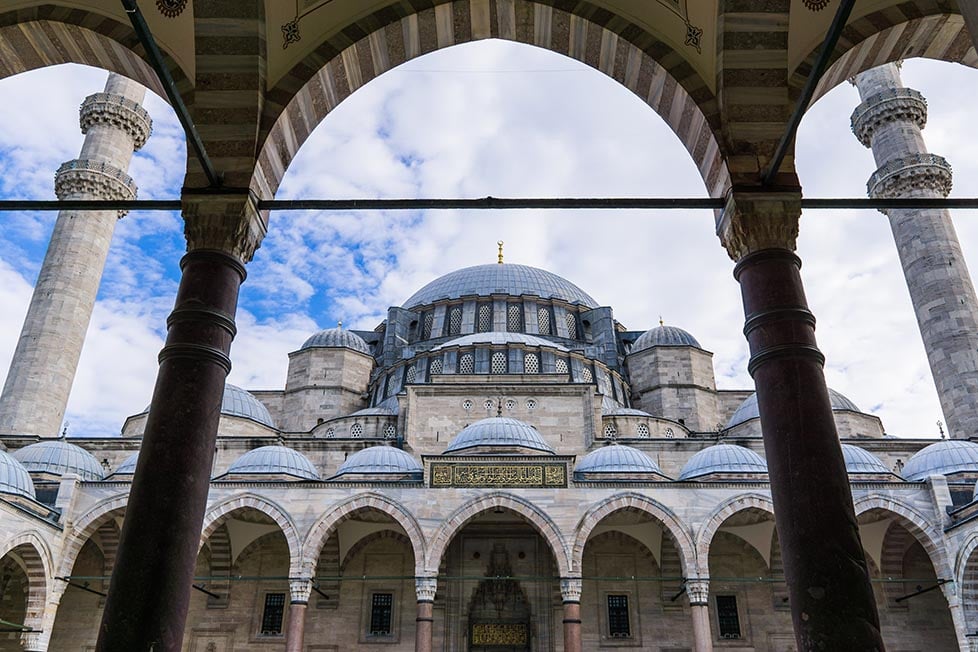
Photo: Nic Hilditch-Short
3. Pack Appropriately for Diverse Climates
Packing for Turkey? Let me save you the headache—this country’s got everything from Mediterranean beaches to frosty mountain trails, so your suitcase needs to be as adaptable as you are. Unless you want to be a sweaty mess by midday, wear breathable cotton shirts and linen pants on the Turquoise Coast’s sweltering summer days.
Bring a lightweight raincoat or a foldable umbrella because spring and fall can bring unexpected downpours. Make that scarf you’re packing a multitasker: use it to block the sun at the beach or wrap up when those winds pick up.
Don’t skimp on shoes, either—grab something sturdy and water-resistant unless you enjoy soggy socks while hiking Cappadocia’s trails or dodging puddles in Istanbul’s cobblestone alleys.
Winter’s a whole different beast: thermal layers, chunky sweaters, and a puffy jacket are non-negotiables if you’re braving Cappadocia’s icy mornings or eastern Anatolia’s snow-dusted valleys. Waterproof boots and gloves are absolutely essential here. My top travel packing tip? Layer like you’re dressing for four seasons in one day.

Image: Nic Hilditch-Short
4. Save Time with Cheap Domestic Flights
Let’s talk about getting around Turkey without losing half your trip to bus naps. This country’s huge—nearly the size of Texas—so domestic flights are your secret weapon. Trust me, after surviving a soul-crushing 10-hour bus ride from Izmir to Cappadocia (think: legroom for ants), I switched to budget airlines like Pegasus or SunExpress and never looked back.
For the price of a nice dinner ($25–60 one-way), you can jet from Istanbul to Antalya in an hour instead of wasting a day in a car. Seriously, those extra hours? Spend ’em sipping cay on the beach or hunting for Roman ruins instead of counting highway signs. My insider tip: Book flights 4–6 weeks early to find the cheapest flights, and always cross-check Turkish Airlines (hello, free checked bags!) with bare-bones airlines like AJet.
Stick to airports like Istanbul’s Sabiha Gokcen or Antalya’s AYT for cheaper routes, and hop on a HAVABUS Shuttle to save cash getting to your hotel. Winter’s your golden ticket—I scored a $30 flight from Istanbul to Cappadocia in January!
But heads up: Pack light. Airlines like Pegasus will nickel-and-dime you for checked bags, so cram that carry-on like a Tetris pro. With over 50 airports, even far-flung spots like Van or Trabzon are just a quick flight away.

Image: Nic Hilditch-Short

Stash your cash safely with this money belt. It will keep your valuables safely concealed, no matter where you go.
It looks exactly like a normal belt except for a SECRET interior pocket perfectly designed to hide a wad of cash, a passport photocopy or anything else you may wish to hide. Never get caught with your pants down again! (Unless you want to…)
Hide Yo’ Money!5. Shop at the Grand Bazaar
The Grand Bazaar in Istanbul is massive, with over 4,000 shops spread across 66 winding streets. One of the best places to visit in Istanbul, you’ll find everything from carpets and jewellery to spices, ceramics, and intricate dishware—but the real gems often hide in the quieter side alleys. These tucked-away corners are far less chaotic and stocked with more unique pieces you won’t spot in the high-traffic zones.
Weekday mornings between 9 and 11 am are the best time to visit the Grand Bazaar for a calmer experience and better odds of landing a deal. The shops not being too populated make for the perfect conditions for haggling a sweet, sweet price. If your haggling skills are rusting, practice gentle haggling—start around half the asking price to score authentic finds and work your way up to a price you’re happy with.
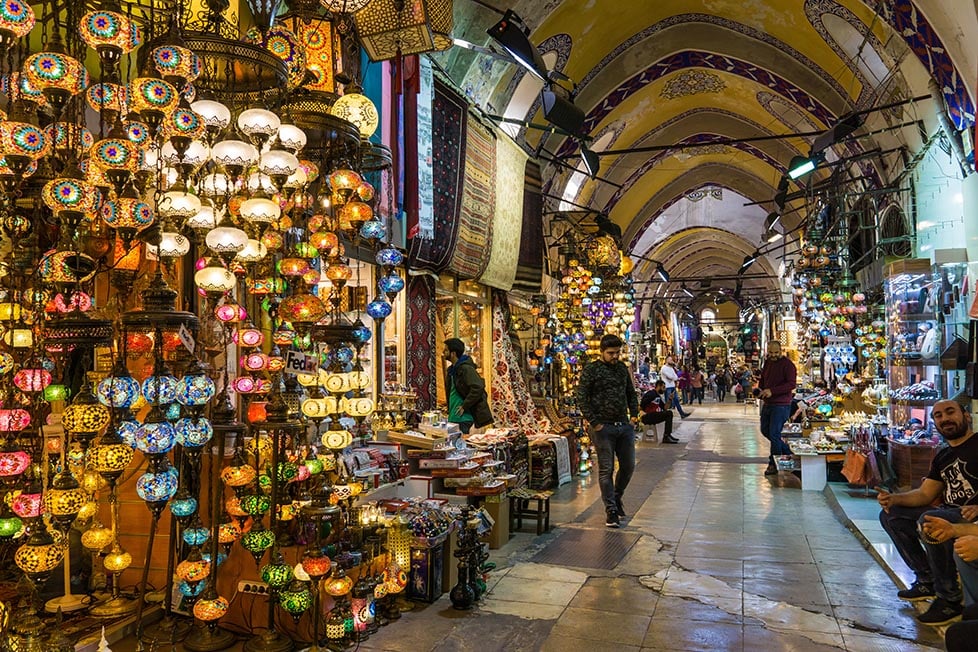
Image: Nic Hilditch-Short
6. Savour Turkish Cuisine
Let me put it this way: Turkish cuisine ruined my diet and my ability to enjoy basic sandwiches. The Turkish food scene is more of a love affair than just a meal. Meat lovers, brace yourselves. Doner kebabs so juicy they’ll drip down your forearm, Adana kebabs that’ll make your taste buds do a double-take, and iskender’s buttery bread-meets-meat sorcery.
But vegetarians aren’t sidelined—stuffed eggplants that melt like velvet and flaky borek pastries, even veggie sceptics will pledge allegiance to. There are a ton of cool food tours in Istanbul that’ll show you the ropes if you’re new to the Turkish grub game.

Image: Nic Hilditch-Short
7. Dine at Local Eateries
What would a trip to Turkey be without getting to sample traditional Turkish food like pide, mezes, and charcoal-cooked lamb dishes? Head to cafés in local neighbourhoods to taste a glimpse of authentic flavours that go beyond tourist menus made from family recipes that have been handed down through the generations.
Street food’s another level here—fresh simit, gozleme, lahmacun, and if there’s a queue, midye dolma stuffed with spiced rice is always worth it, especially with a cold ayran. Dishes like kokorec and kumpir turn a quick bite into something genuinely memorable, and suddenly dinner’s the best part of the day.
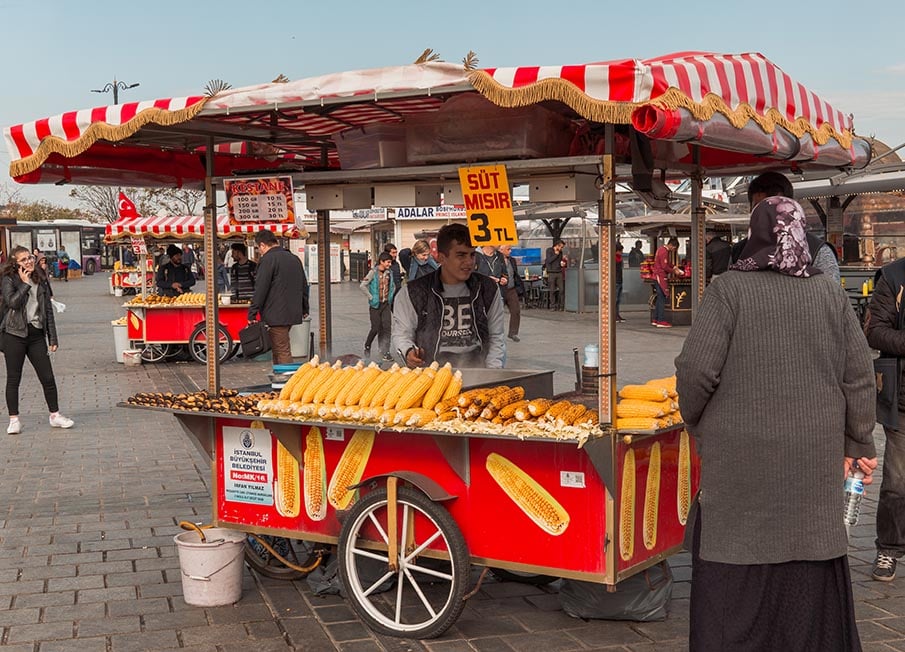
Image: Nic Hilditch-Short
If the idea of street food overwhelms you, the best way to get involved is with a food tour. You’ll hit hidden local spots and boutique markets while eating your way through the city. The guides know their stuff and tie each bite to local stories, culture, and tradition. It’s a solid intro to Turkish food without the guesswork.
8. Sip Turkish Tea
This Turkey travel guide wouldn’t be complete without a nod to the country’s tea culture, which runs deep from sunrise to sundown. Cay—black tea served in tulip-shaped glasses—shows up everywhere, from homes and shops to tea gardens, always as a gesture of welcome.
No matter where you go, the act of tea-making is a daily routine that brings the community together in this country. Some of my best moments came over a strong glass of tea, trading stories and playing board games with locals in small, no-frills cafes.
Since it’s hard to find anything quite like this tea outside Turkey, I always stash a pack of loose-leaf tea in my bag before heading home.
9. Treat Yo’self to a Traditional Hammam
Heading to a traditional hammam is more than just a way to unwind—it’s a proper deep dive into Turkish culture. The experience is as much about the ritual as the relaxation.
Some of the best hammams in Istanbul include Cemberlitas Hamami, Hurrem Sultan Hamam, and Galatasaray Hamam, each with its own unique history and atmosphere. For couples, Suleymaniye Hamam offers a more private experience and is one of the few that allows mixed-gender bookings, which can be a rarity in traditional setups.

Beyond the experience itself, Turkish baths come with a few added perks—better circulation, less tension, and skin that feels properly cleaned and refreshed. There’s something about that mix of heat, steam, and traditional exfoliation that just clears the slate. If your Turkey itinerary’s feeling packed and you’re starting to drag, a good hammam session hits the reset button.
10. Respect the Power of the Evil Eye
I first noticed the evil eye charm—called nazar boncugu—everywhere in Turkey. You’ll find these blue glass beads hanging in shops, cafes, and taxis. They’re believed to protect you from envy and bad luck. I always pick up a small one to clip on my backpack or place near my hotel door. You can buy them in bazaars and tourist shops for just a few lira.
When a friendly shopkeeper offers you a bead, accept it as a kind gesture. Wear or display it during your travels to blend in with local customs. If someone taps their beads or points at them, they’re warding off negative energy on your behalf. Carrying one with you shows respect for Turkish superstitions and makes for a memorable and cultural souvenir. Keep your charm handy and embrace the good vibes of the evil eye in Turkey!

Image: Nic Hilditch-Short
I stumbled on the Ani Ruins by accident, and honestly, it’s one of the most beautiful spots I’ve found in Turkey. Tucked near the Armenian border, its crumbling walls and towers still cling to what’s left of the so-called City of 1001 Churches. It’s not just Ani, either—Sogmatar Ancient City and the Stadium of Magnesia, sitting on opposite ends of the country, are scattered with stone carvings and remnants of lives long gone.
These lesser-known archaeological sites make it clear that Turkey’s ancient history goes well beyond the usual Ephesus and Troy circuit. Slotting these ancient cities into your Turkey travel guide means getting far deeper into the country’s past than most ever bother to go.
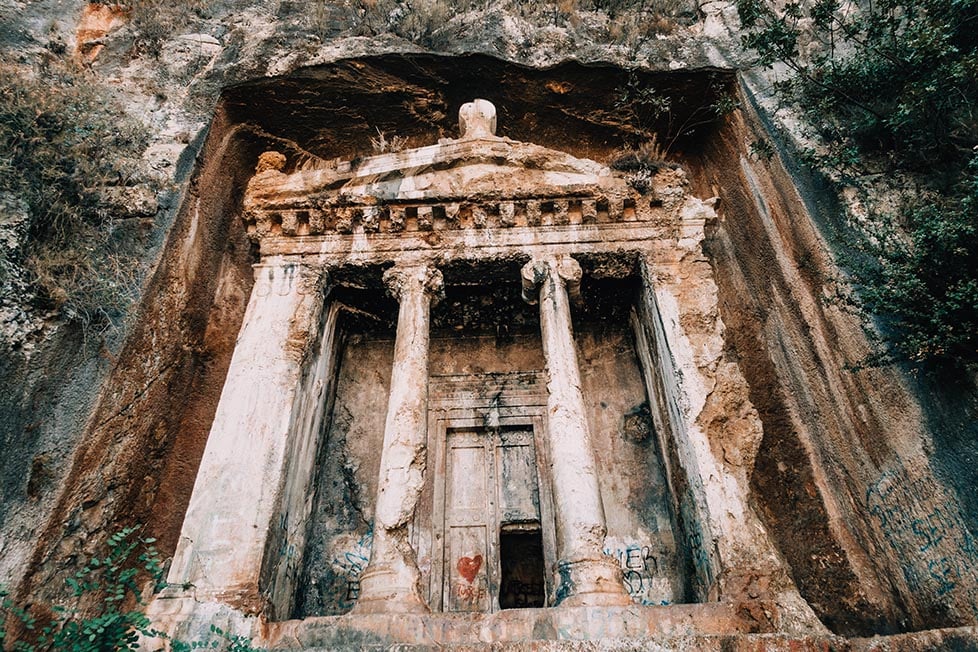
Image: Nic Hilditch-Short
12. See the Sunrise at Mount Nemrut
Catching the famous sunrise at Mount Nemrut was one of the top things I wanted to do during my time in Turkey. Sunrise usually happens around 06:27 am, and as most drive at least two hours from Kahta, it makes for an early start. As dawn breaks, the colossal heads of gods on the eastern terrace glowed in soft red hues—an unforgettable moment worth the early wake-up call.
The best time to visit Mount Nemrut is between May and September, when roads are clear and the weather is mild, as winter often closes the site due to snow. Pack warm layers—a jacket, hat, and gloves—since the temperature at the summit can be below zero before sunrise.
To save yourself the hassle, staying overnight in Karadut or Adiyaman helps, especially if you join a guided tour that handles the transport and dives into the site’s backstory. For anyone into ancient history or sunrise photography, this place earns its reputation without any need for hype.
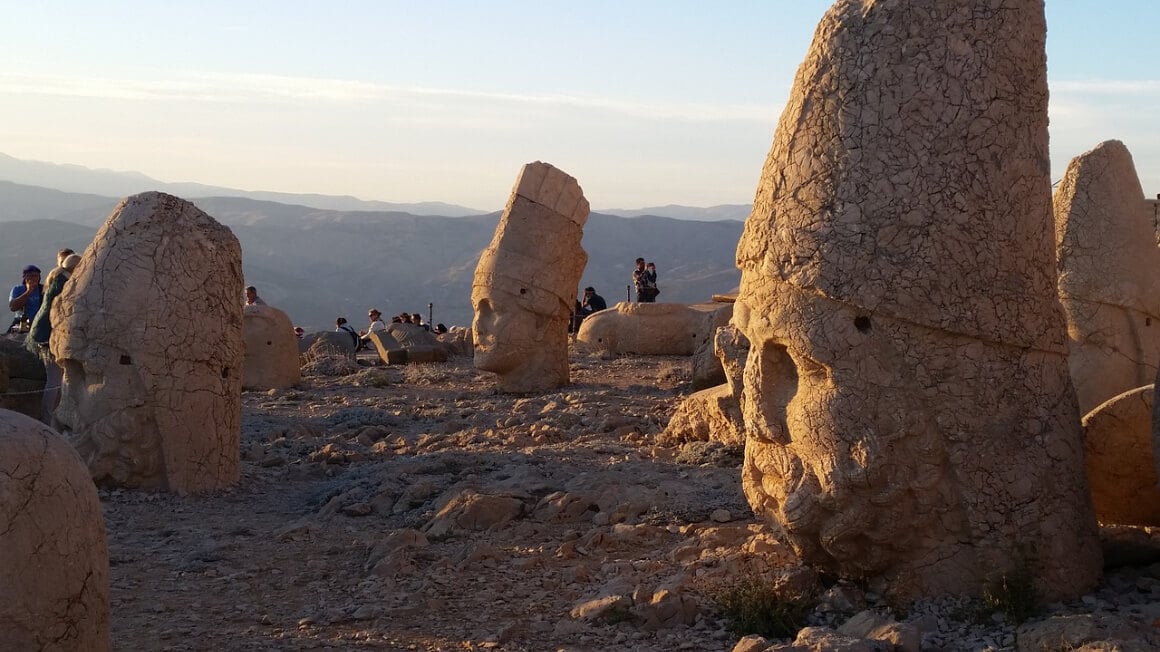
13. Sip Turkish Coffee
Stepping into a century-old Turkish coffee house ruined me for Starbucks forever. Baristas here simmer unfiltered brew in a copper cezve like it’s liquid alchemy. The magic starts with super-fine grounds, cold water, and a pinch of sugar, all heated just slow enough to whip up that iconic foam crown.
Cafes here are more than just a place you grab your usual order in the morning, they’re gossip hubs, chess battlegrounds, and time capsules rolled into one. And yeah, the fal fortune-telling? After downing your cup, someone will flip the sludge and spin tales about your future like a caffeinated oracle.
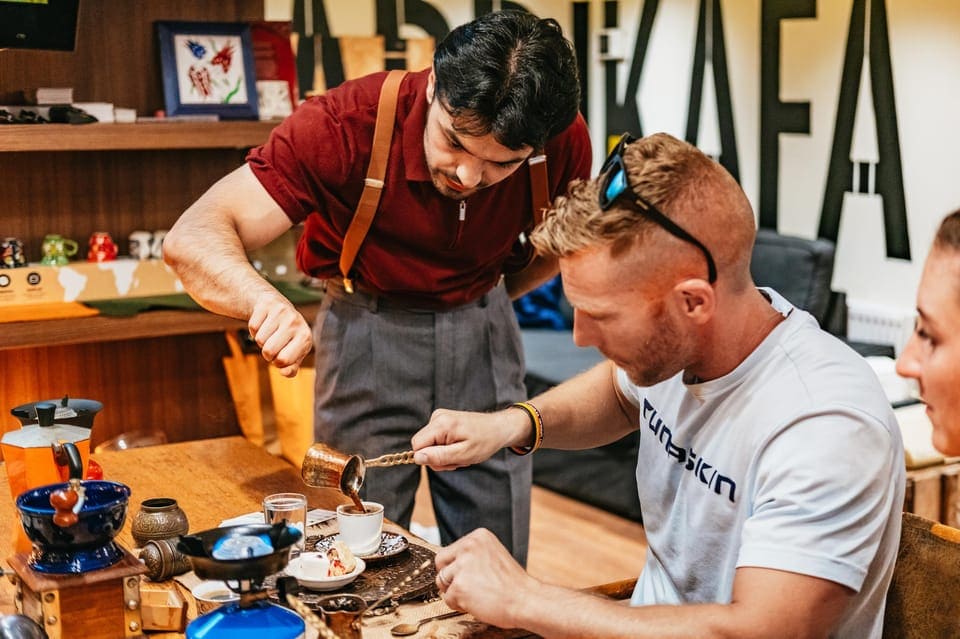
One of the best places to drink Turkish coffee is Mandabatmaz on Istiklal Street—their foam is so thick, spoons stand upright. And don’t skip Kurukahveci Mehmet Efendi’s shop, where they’ve been hand-grinding beans since the Ottoman Empire was kicking about.
This tour goes one step further and lets you dive into Turkish coffee making and its culture. It even brushes you up on the magic that goes behind fortune telling. If you’re a coffee nerd like me, it’s certainly not one to miss.
14. Hike to Sumela Monastery
The hike up to Sumela Monastery in the scenic Altindere Valley near Trabzon ranks high for history buffs and nature lovers alike. Reaching the cliffside complex, you enter a 1,600-year-old monastery carved into the rock face, where faded frescoes and hidden chapels reveal ancient secrets. You can explore the chambers and terraces, soaking in endless mountain views and the distant Black Sea mist.
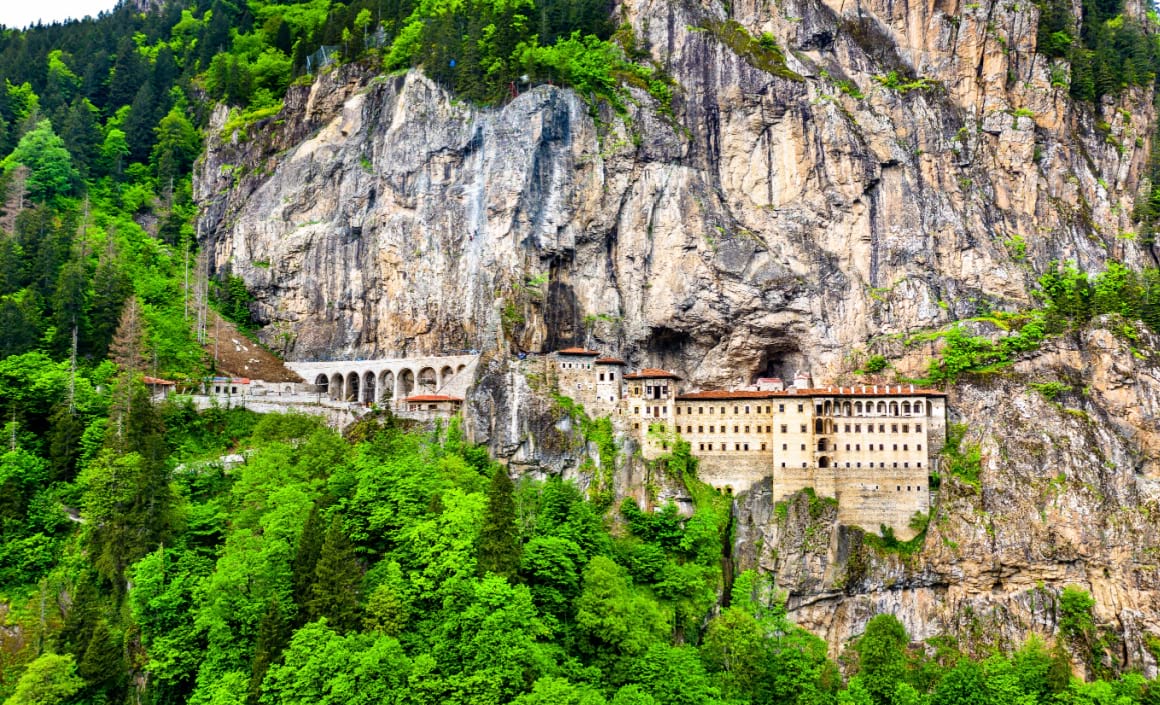
Entrance costs around 450 Turkish Lira, or you can show a Museum Pass for free entry to multiple archaeological sites in Turkey. To beat the crowds, plan your hike early—arrive right at opening when the shuttle starts running. For the full experience and some solid history thrown in, a guided tour is the way to go—these guides don’t waste time and dive straight into the region’s rich culture.
15. Cappadocia Isn’t Just for Hot Air Balloons
A Cappadocia balloon tour at sunrise, drifting above fairy chimneys in soft light, is one of the most magical experiences you can have in Turkey. It gives you a bird’s eye view of Göreme’s otherworldly spires and distant Erciyes Mountain.
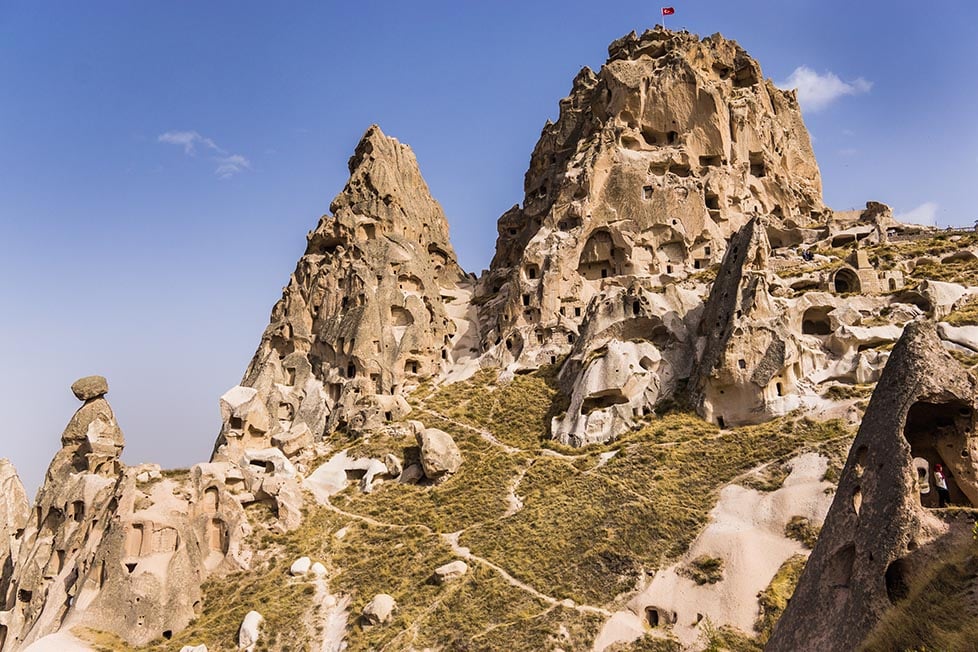
Image: Nic Hilditch-Short
But Cappadocia isn’t just balloons—you can hike through Love Valley’s rose-tinted cliffs and explore churches carved into caves in the Ihlara Valley. Don’t forget to venture underground to Derinkuyu’s ancient depths, an 8th-century BC city that once sheltered 20,000 people in its multi-level tunnels.
Spring or fall are the best times to visit Cappadocia. April through June and September through October are those months. The weather is nice, fewer tourists are around, and balloons fly every day.
16. Road Trip Along the Turquoise Coast
If you’re looking for some insane coastal views, a road trip down the Turquoise Coast in Turkey is one to put on the bucket list. Also known as the Turkish Riviera, the road covers roughly 600 km between Antalya to Fethiye. It passes small beach towns like Kemer, Kas, and Gocek, and you can expect stretches of big cliffs that drop into clear blue water near Fethiye.
The best time to road trip the Turquoise Coast is April to June or September to October, when temperatures hover around 24°C and crowds thin out. Budget travellers can find charming guesthouses in Kas or Kalkan to experience authentic village life between beach hops. Make sure to stop at the old Lycian cities, Xanthos and Patara—they are close by and give you a glimmer of what ancient Turkey looked like.
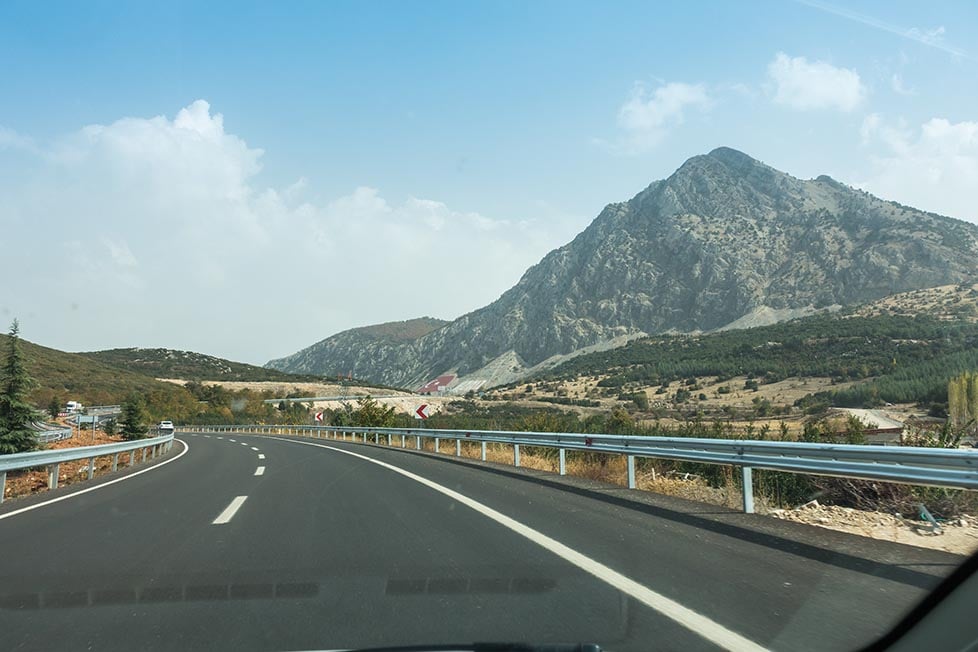
Image: Nic Hilditch-Short
17. Learn 5 Key Turkish Phrases
If you want to really impress the locals, learning a couple of Turkish phrases will give you a cheeky grin and might even be the thing that sweetens the deal during haggling.
- Hello – Merhaba (say it like mer-ha-ba). Super simple.
- Want to thank someone? Use tesekkur ederim (sounds like te-sheh-kur eh-deh-reem). Locals love it when you try!
- Need to ask a price? Just say Ne kadar (that’s neh ka-dar). Works like a charm in markets.
- Looking for the restroom? Try Tuvalet nerede (too-va-let neh-reh-deh). Gets the job done fast.
- Before you dig into a meal, say Afiyet olsun (read it as ah-fee-yet ol-soon). It’s like saying “Enjoy!”
Tossing these into your conversations adds a bit of charm and shows you’re not just another clueless tourist—give ’em a try!
18. ALWAYS Travel With Insurance
Turkey is a pretty safe place but that doesn’t mean things can’t go wrong. Even to the best of us backpackers.
Nothing kills a trip more than unexpected medical bills or losing your phone. Prepare for the worst and expect the best by making sure you take out good travel insurance before your trip to Turkey. Pass those unexpected expenses onto your insurance provider!
ALWAYS sort out your backpacker insurance before your trip. There’s plenty to choose from in that department, but a good place to start is Safety Wing.
They offer month-to-month payments, no lock-in contracts, and require absolutely no itineraries: that’s the exact kind of insurance long-term travellers and digital nomads need.
SafetyWing is cheap, easy, and admin-free: just sign up lickety-split so you can get back to it!
Click the button below to learn more about SafetyWing’s setup or read our insider review for the full tasty scoop.
Final Thoughts on Turkey Travel Tips
There it is—my top Turkey travel tips to help you explore this vast country, from the bustling bazaars of Istanbul to Cappadocia’s fairy chimneys and the sun-drenched Turquoise Coast.
By choosing the right season, respecting local customs, tasting authentic cuisine, and uncovering hidden ruins, you’ll see why tourism makes up around 8% of Turkey’s economy and draws millions each year.
Use these Turkey travel tips to design your own adventure—blending history, culture, and nature for memories that will last a lifetime.
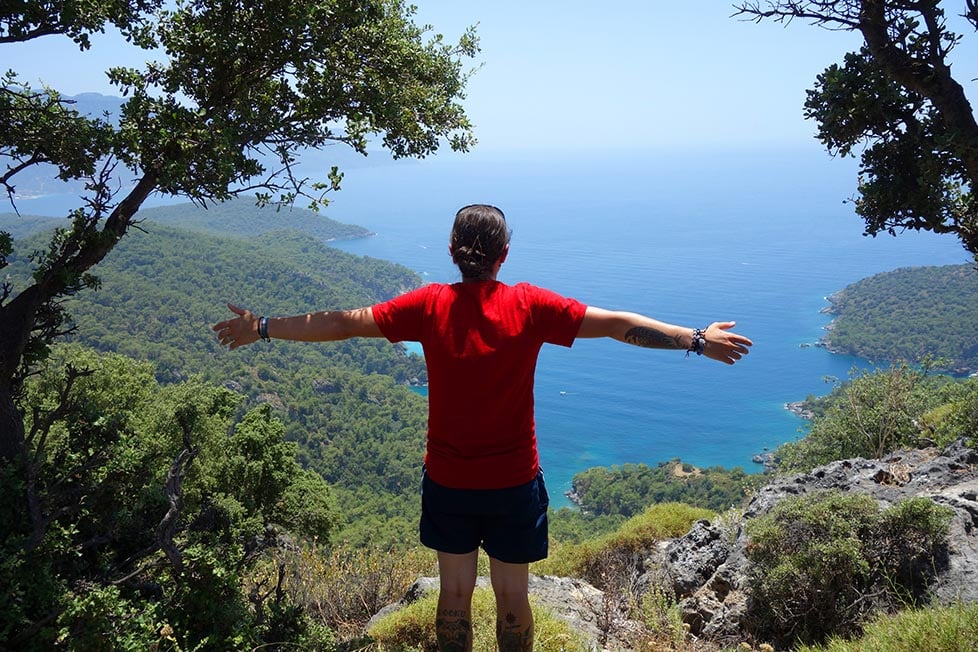
Image: Nic Hilditch-Short
- Become a MASTER traveller with our epic travel tips.
- Embrace your backpacker spirit and travel off the beaten path, because… why not?
- Our killer guide to living in hostels will transform your stay. Check it out!
- Get off the couch and into the great outdoors with our hiking guide.
Buy Us a Coffee!
A couple of you lovely readers suggested we set up a tip jar for direct support as an alternative to booking through our links, since we’ve decided to keep the site ad-free. So here it is!
You can now buy The Broke Backpacker a coffee. If you like and use our content to plan your trips, it’s a much appreciated way to show appreciation 🙂



